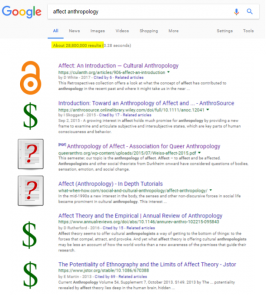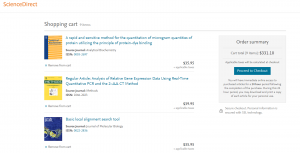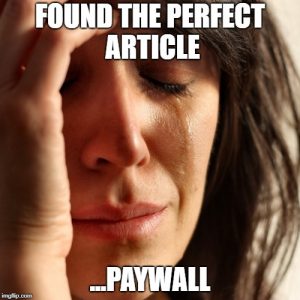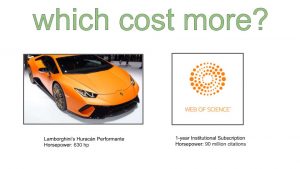Topic
|
Paywalls and Information Costs
|
| Key Takeaways |
- Scholarly publications are not typically free to access and subscription costs for certain resources are exorbitant. Journals in certain disciplines (especially engineering, business, & medicine) have higher price tags than others.
- While a lot of scholarly content is discoverable on Google, attempting to access the full text often leads to a page from a publisher asking for money, a paywall.
- Since individuals cannot afford to buy/subscribe to journals, university libraries pay large sums of money to provide institutional access.
|
|
Notes for the instructor/librarian
|
The topic of paywalls and information costs would be good for any intro-level student to learn about early on. Paywalls are a jarring reminder of the fact that access to scholarly publications is restricted and costs a lot of money. This topic may naturally inspire discussion of “information privilege” and the impact paywalls may have on researchers without institutional access. The issue of piracy (e.g., Sci-hub) might also come up and librarians and instructors should be prepared to discuss the ethics of this.
|
| Lesson Content |
Below you will find a variety of ways to briefly address this topic. Pick, choose, and adapt as you like. |
| Quick Mentions |
- When teaching a class and discussing databases, talk to them about how much the library pays to subscribe and provide access. Also mention that students will lose access to most of our databases upon graduation.
- Mention alternative Open Access sources of information: public libraries, Google Scholar, unpaywall.org, Open Access Button, etc.
- When talking to students about researching from off campus, explain paywalls – 1). why they exist (conceptual); 2). what to do when you hit them (practical – go through the library’s website).
- Factoids by the numbers (based on Duke Libraries research):
- 59 of 100 of the most highly cited articles ever published are behind a paywall.
- The average cost of one of these articles for an unaffiliated researcher is $33.41. One Nature article typically costs an unaffiliated researcher $32.
- If the 244,133 authors who cited the article “CLEAVAGE OF STRUCTURAL PROTEINS…” (1970) paid out-of-pocket for access to this Nature article ($32), the price tag would total $7,821,256.
|
| Discussion Questions |
- Have you run into paywalls on the internet? What were you trying to access when you hit the paywall? What did you do? Give up? Pay? Go elsewhere?
- What types of information do you think should be free (ex. News? Entertainment? Medical? Government-funded research?)?
- React to this statement: “A huge part of research output is suffocating behind paywalls. Sixty-five of the 100 most cited articles in history are behind paywalls… That’s the opposite of what science is supposed to do…We’re not factories producing proprietary knowledge. We’re engaged in debates, and we want the public to learn from those debates.” — Guy Geltner, professor/historian at the University of Amsterdam & open access advocate, Wired magazine
- React to this statement about The Guardian newspaper: “I appreciate there not being a paywall: it is more democratic for the media to be available for all and not a commodity to be purchased by a few. I’m happy to make a contribution so others with less means still have access to information.” —Guardian reader
- What is the impact of information costs on under-resourced institutions?
|
| Visuals & Media
(See all content in Google Drive) |
- Tenontosaurus example: This is what hitting a paywall looks like in real life and how researchers get around this (#icanhazpdf). This example illustrates a very common phenomenon and introduces the phenomenon of the hashtag #icanhazpdf with the solution (in this example) to retrieve the article from an online piracy site (Sci-Hub).
- Activity variation: Search for the hashtag #icanhazpdf on Twitter. What are you noticing?

- Screenshot of Google Results with $ signs next to the paywalled items.

- A Sciencedirect “Shopping Cart”:

- Paywall memes. Could be inserted into presentation slides.
 
|
| Activities
(See all content in Google Drive) |
- Bibliography Price Tags: Give students a small list of sources and ask them to total up the cost of each source using the web to find prices. Discuss: Were you surprised with the prices? Why do you think different kinds of information cost different amounts of money?
- Kozlowski Ryszard M., Mackiewicz–Talarczyk Maria, Muzyczek Malgorzata & Barriga–Bedoya Jorge (2012) Future of Natural Fibers, Their Coexistence and Competition with Man-Made Fibers in 21st Century, Molecular Crystals and Liquid Crystals, 556:1, 200-222, DOI: 10.1080/15421406.2011.635962
$________________
- Dani Setiawan, Jeffrey Brender & Yang Zhang (2018) Recent advances in automated protein design and its future challenges, Expert Opinion on Drug Discovery, 13:7, 587-604, DOI: 10.1080/17460441.2018.1465922 $________________
- Pickles Sector: Worldwide Forecast until 2022 (2018). https://www.reportlinker.com/p03859343/Global-Pickles-Market.html $________________
- Oxford Textbook of Global Public Health, 6th Edition. Available for rent on Google Play. $________________
- Answer key: $50+$89+$2,500+151.99=$2,790.99
- Variation – which do you think has the highest price tag? Why?
- “Which cost more?” / Price is Right-style game: Show students a few different resources and ask them to guess the price.
  
|
| Student Readings |
|







